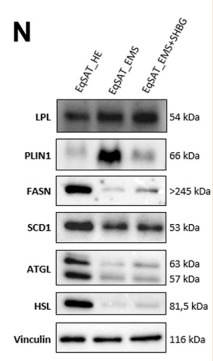LIPL Antibody - #DF12534
| 製品: | LIPL Antibody |
| カタログ: | DF12534 |
| タンパク質の説明: | Rabbit polyclonal antibody to LIPL |
| アプリケーション: | WB |
| Cited expt.: | WB |
| 反応性: | Human, Mouse, Rat |
| 予測: | Pig, Bovine, Horse, Sheep, Rabbit, Dog |
| 分子量: | 55 kDa; 53kD(Calculated). |
| ユニプロット: | P06858 |
| RRID: | AB_2845496 |
製品説明
*The optimal dilutions should be determined by the end user. For optimal experimental results, antibody reuse is not recommended.
*Tips:
WB: For western blot detection of denatured protein samples. IHC: For immunohistochemical detection of paraffin sections (IHC-p) or frozen sections (IHC-f) of tissue samples. IF/ICC: For immunofluorescence detection of cell samples. ELISA(peptide): For ELISA detection of antigenic peptide.
引用形式: Affinity Biosciences Cat# DF12534, RRID:AB_2845496.
折りたたみ/展開
EC 3.1.1; EC 3.1.1.34; HDLCQ11; LIPD; LIPL_HUMAN; Lipoprotein lipase; LPL; LPL protein; MGC137861;
免疫原
A synthesized peptide derived from human LIPL, corresponding to a region within the internal amino acids.
Detected in blood plasma (PubMed:2340307, PubMed:11893776, PubMed:12641539). Detected in milk (at protein level) (PubMed:2340307).
- P06858 LIPL_HUMAN:
- Protein BLAST With
- NCBI/
- ExPASy/
- Uniprot
MESKALLVLTLAVWLQSLTASRGGVAAADQRRDFIDIESKFALRTPEDTAEDTCHLIPGVAESVATCHFNHSSKTFMVIHGWTVTGMYESWVPKLVAALYKREPDSNVIVVDWLSRAQEHYPVSAGYTKLVGQDVARFINWMEEEFNYPLDNVHLLGYSLGAHAAGIAGSLTNKKVNRITGLDPAGPNFEYAEAPSRLSPDDADFVDVLHTFTRGSPGRSIGIQKPVGHVDIYPNGGTFQPGCNIGEAIRVIAERGLGDVDQLVKCSHERSIHLFIDSLLNEENPSKAYRCSSKEAFEKGLCLSCRKNRCNNLGYEINKVRAKRSSKMYLKTRSQMPYKVFHYQVKIHFSGTESETHTNQAFEISLYGTVAESENIPFTLPEVSTNKTYSFLIYTEVDIGELLMLKLKWKSDSYFSWSDWWSSPGFAIQKIRVKAGETQKKVIFCSREKVSHLQKGKAPAVFVKCHDKSLNKKSG
種類予測
Score>80(red) has high confidence and is suggested to be used for WB detection. *The prediction model is mainly based on the alignment of immunogen sequences, the results are for reference only, not as the basis of quality assurance.
High(score>80) Medium(80>score>50) Low(score<50) No confidence
研究背景
Key enzyme in triglyceride metabolism. Catalyzes the hydrolysis of triglycerides from circulating chylomicrons and very low density lipoproteins (VLDL), and thereby plays an important role in lipid clearance from the blood stream, lipid utilization and storage. Mediates margination of triglyceride-rich lipoprotein particles in capillaries. Recruited to its site of action on the luminal surface of vascular endothelium by binding to GPIHBP1 and cell surface heparan sulfate proteoglycans.
Tyrosine nitration after lipopolysaccharide (LPS) challenge down-regulates the lipase activity.
Cell membrane>Peripheral membrane protein>Extracellular side. Secreted. Secreted>Extracellular space>Extracellular matrix.
Note: Newly synthesized LPL binds to cell surface heparan proteoglycans and is then released by heparanase. Subsequently, it becomes attached to heparan proteoglycan on endothelial cells (PubMed:27811232). Locates to the plasma membrane of microvilli of hepatocytes with triglyceride-rich lipoproteins (TRL). Some of the bound LPL is then internalized and located inside non-coated endocytic vesicles (By similarity).
Detected in blood plasma. Detected in milk (at protein level).
Belongs to the AB hydrolase superfamily. Lipase family.
研究領域
· Human Diseases > Neurodegenerative diseases > Alzheimer's disease.
· Metabolism > Lipid metabolism > Glycerolipid metabolism.
· Organismal Systems > Endocrine system > PPAR signaling pathway.
· Organismal Systems > Digestive system > Cholesterol metabolism.
参考文献
Application: WB Species: Human Sample: adipose tissue
Restrictive clause
Affinity Biosciences tests all products strictly. Citations are provided as a resource for additional applications that have not been validated by Affinity Biosciences. Please choose the appropriate format for each application and consult Materials and Methods sections for additional details about the use of any product in these publications.
For Research Use Only.
Not for use in diagnostic or therapeutic procedures. Not for resale. Not for distribution without written consent. Affinity Biosciences will not be held responsible for patent infringement or other violations that may occur with the use of our products. Affinity Biosciences, Affinity Biosciences Logo and all other trademarks are the property of Affinity Biosciences LTD.


